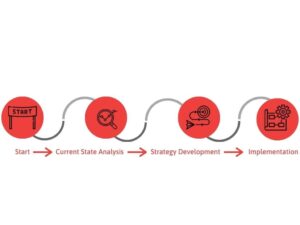Radical digital change is affecting the world in which we live and work. New technologies have created new markets that, in turn, create new competitors and new customers. And those competitors and customers are having new expectations. The pace of change doesn’t seem to be slowing down.
To succeed in this digital era, businesses must not only provide superior experiences for customers, employees and citizens, but also deliver on their promises in a faster, more agile way. The opportunities are extensive, but only for organizations that understand how far and fast they have to transform. For several businesses, digital transformation is at the core of pushing them forward. When done the right way, it can help organizations obtain sustainable development and stay ahead of their competition. However, since technology is always expanding gradually, some companies don’t know where to start.
Therefore, this article is written to help your business answer the three questions below in order to integrate into the new digital era successfully:
- What is digital transformation about?
- How has the COVID-19 pandemic changed digital transformation?
- Step-by-Step Instructions to Digital Transformation.
1. What is digital transformation about?
Digital transformation is all about using technology to solve traditional problems. When done correctly, it permits businesses to provide unprecedented experiences to their customers and constantly evaluate their strategies and tactics. During a digital transformation, digital technology is merged into every aspect of the business, from service to sales and beyond. Several companies work in silos, where each area or department has its own data or technology that varies from department to department in the company. Digital transformation breaks down those silos to make a more seamless experience across the organization, both internally and externally.
Digital transformation doesn’t have a set beginning or endpoint. Instead, it’s a state of mind for a company to gradually develop and adopt new digital solutions for their customers. Technology and customer behavior alter every couple of years, and organizations have to stay ahead of the curve. Every aspect of the company, especially marketing and IT, has an essential role to play in digital transformation.

Digital Transformation
2. How has the COVID-19 pandemic changed digital transformation?
When Covid-19 struck, it forced societal changes all over the world. Governments issued orders that prohibited crowded gatherings, restricted in-person business operations, and suggested people work from home as much as possible. In response, businesses have been forced to accept that introducing technology into their working systems does not have to be perfect. Organizations across different industries have been able to adapt to these changes significantly faster than expected.
But many organizations struggling to adapt to the challenging circumstances that the pandemic has created, nobody wants to deal with high turnover that can come from low employee satisfaction and the costs that come with hiring new employees. Instead, paying attention to the importance of making a positive digital experience for workers has a great benefit for businesses. At the same time, businesses have also been forced to concentrate on the convenience with which their customers can engage with them digitally. With customers doing most of their interactions with brands digitally, businesses must prioritize making sure that their customers don’t have problems shopping and converting on their websites or apps.

Making a positive digital experience
3. Step-by-step instructions for digital transformation.
In order to create a successful digital transformation roadmap, it’s recommended to break the roadmap into phases which show a step by step and a to-do list. Following these instructions, you will end up with a planning list that tells you what you should do next, instead of the vague general information given by many articles out there.
There are the 4 phases which include a total of 10 steps, that your companies should do in the beloz order:

Step-by-Step Instructions to Digital Transformation
Phase 1: Start
Step 1: Project Start
- Define project team leader and members
- Make the project known within your company
- Decide on the way to report on project progress within your organization
- Understand the change protocol worksheet
Phase 2: Current State Analysis
Step 2: Analyze the external effects on your business
- Get to understand the “PESTLE-Analysis” tool
- Teamwork: Analyze the external influences on your business with PESTLE
- Use the worksheets and write down in the altered protocol any ideas that are already emerging about what to transform
Step 3: Analyze the strengths and weaknesses of your organization
- Get to understand the “GAP-Analysis” tool
- Teamwork: Analyze your strengths and weaknesses with GAP-Analysis
- Use the worksheets and write in the altered protocol any ideas that are already emerging about what to transform
Step 4: Describe your current business model
- Get to understand the “CANVAS Business Model” tool
- Teamwork: Describe your current business model with CANVAS
- Use the examples and the chart and write down any ideas within the change protocol
Phase 3: Strategy Development
Step 5: Collect facts and suggestions
- Study the success factors for digital business models
- Learn from pioneers in your own market and review their success factors
- Observe your competitors and analyze the market, involving your coworkers and employees during this process
- Analyze the demands and buying decisions of your customers and the reasons why people potentially don’t become your customers
- Write down any ideas that emerge within the change protocol
Step 6: Get to understand the “driving forces” behind digital transformation and check how applicable they are to your business
- Get to understand the 10 digital technologies
- Teamwork: Discuss your understanding of the 10 digital technologies
- Teamwork: Decide which of the new digital technologies could be applicable to your business and how they could be applied
- Write down any ideas that emerge in the change protocol
Step 7: Develop your new business strategy
- Teamwork: Adapt your business strategy or develop a new one with the SWOT-Analysis
- Consider the ideas from the change protocol and write down any new ideas
Step 8: Describe and develop your new business model
- Teamwork: Adapt your business model or develop a new one with the results from your SWOT-Analysis and the ideas from the change protocol
- Describe the new business model with CANVAS
Phase 4: Implementation
Step 9: Arrange and prioritize the planned activities
- Define criteria for the process of prioritization
- Evaluate the urgency of the planned activities
- Evaluate the result of the planned activities
- Check available resources (personnel and financial)
- Evaluate the priorities
Step 10: Start, accomplish and review implementation
- Determine who will be the digitalization agent and who they will work with. Make this decision known to your organization
- Decide the way to report on the progress of implementation within your organization
- Review whether the planned milestones have been achieved and whether this is in accordance with the budgets
- If the planned activities have to be altered, consider the ideas in the change protocol
- Compare the achieved results with your targets and decide if and when to start a new project cycle from step 1
Digital transformation doesn’t finish after you’ve successfully implemented your plan. It is, by definition, an ongoing process. First, technology updates happen frequently (and automatically within the cloud), and you have to be ready and prepared to take advantage of the new features and opportunities of those updates. Second, the market is constantly changing, as are customer demands and needs. A successful transformation is one that is able to support a dynamic environment while maintaining usability and productivity. Keep an open mind. Stay informed about technology and market shifts, and stay tuned into what’s happening internally, and your transformation will continue to evolve along with your organization.
You might be ready to get your digital transformation started but absolutely need assistance and support to push it as fast as possible, contact Kyanon Digital to get it done correctly and successfully.


